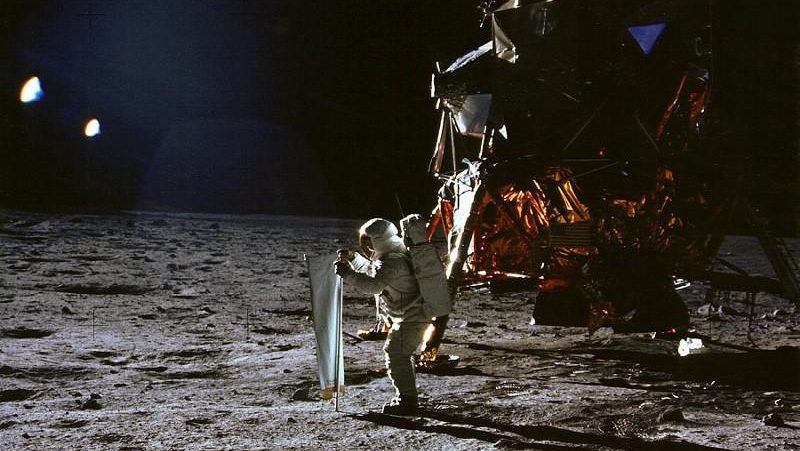Technologies used by arid countries could be used in space, says Dickson Despommier.
Question: What other food growth technologies are being developed?
Dickson Despommier : And then there’s another technology called aeroponics where you suspend the roots in a plastic container and then atomize the nutrients in a very small amount of water. It’s a huge success in terms of saving water and feeding plants at the same time. The Israelis are using it like crazy.
So a lot of these technologies were developed by desert dwellers with high degrees of technology, and Israel was one of those places, and the University of Arizona and Tucson is another place where controlled indoor farming has been developed to a very, very high level, and in fact the reason why is because NASA would love to grow food on Mars. All right.
I guess they think everything is collapsing and they have to leave soon. Too bad. You have to do it here first. You have to learn how to do it here first. Okay, so even if you want to live on Mars or you want to develop a moon colony here, or you want to live in a space station, you just-- you know how much it cost to shuttle food up there? Dominoes does not deliver in this area. I’m sorry.
You can call them and they’ll say, “Where are you?”
“The dark side of the moon.” Yeah, I know. That was a Pink Floyd album as I recall. You’re basically committed to reinvent agriculture if you want your food to be as close to your plate as it can possibly be in order to save fossil fuel use, in order to avoid food spoilage. In order to get a continuous growth of crop. In order to avoid weather-related crop failures.
I’m now giving you the reasons why vertical farming started to appeal to me as an economic exercise first, and the next year of course I went back to the class and I said, “Hey, guess where our project is this year? Now we get to talk about farming inside buildings in large quantities.” I said “What can we farm inside anyway? That’s your project for the year. You tell me what we can grow indoors to confluence, to commercial levels.”
And they came back with a huge list because NASA already had that list. It was an easy way. They pretended that they really worked their tails off, but actually, it took them like three hits off the Internet to get the answer and that’s too bad. Okay, you need to do more. So how much more do we need to do in order to ensure the fact that we’ve got solid evidence that raising food indoors is a good idea? The best evidence is commercial viability. So they found this website called Eurofresh. Eurofresh is a farm outside Tucson, Arizona. It’s 40 acres. It’s huge. They raise tons of tomatoes. The only thing wrong is you’ve got to ship them someplace, and Phoenix doesn’t consume all those tomatoes, neither does Tucson, so the fact is you’re still shipping food some other place, but it’s done without soil. It’s done in the middle of the desert where you have an unlimited supply of sunlight, and so it’s a great idea because land is cheap. The sun is free and they’ve made a fortune by the way. They’ve really succeeded. Now they’re branching out into green beans and cucumbers, and I guess they’re going to go into a bunch of fruits also because it’s been economically viable to do this.
They’re not the only one that’s done it. In the wintertime go to Fairway Market in New York City and you can buy tomatoes from Holland or from New Zealand, again, a little bit far away from me I think. And it’s $3.99 a pound. This year it will be $4.99 a pound in order to keep up with the fair trade agreements because soil-based tomatoes have now doubled in price. And the reason of course is because fossil fuels have gone up, and people are now growing things that are not food items for bio-fuel production and this sort of thing, so it’s making a big switch in terms of our crop selections. Okay, so back to the story. That was very encouraging.
The second year’s results were extremely encouraging because not only can we raise food inside. We can raise almost everything we need. Not everything. You can’t raise a cow inside, okay? You can’t raise-- well, you can raise pigs inside if you’d like. A lot of animal rights people would object to that so we’ve eliminated that as a possibility. But no one objects to chickens. I don’t know why. They’re just edibles too, but apparently the feeling is that they’re modern dinosaurs, right? Birds are modern dinosaurs so therefore you can kill them because dinosaurs are mean, nasty critters. Shrimp farming is a viable option here. Mollusks of various kinds. In fact agriculture is really a fantastic adjunct to the vertical farm concept.
So when you add it all up, you could in a single building have all the four main food groups. You would have your vegetables, and your starches and you’d have fats with regards to the animal products from these crops that I just mentioned to you. And you can have spices and herbs and everything else you’d need in order to live comfortably except for beef. So that was great. We made a big list of these things, so the third year out, that was the crunch year. Third year was how big a building do you need to feed 50,000 people? Let’s get real about this. Show me. If I have to build this thing up to the stratosphere forget about it. It’s just not going to work, so tell me. Here are the crops. Here are the methods. Show me what’s possible with the building and you’ve got as much land and as much money as you want. Go ahead. And they had a great time with this one because you know, when you’re given an infinite amount of money your tendency is to spend it all. But they didn’t. They actually came up with a realistic building. The building was only 30 stories tall, and the footprint was one square city block of New York. That’s five acres of land, basically. And the reason why they could feed 50,000 people a year was not obvious from just those figures. What they would have to do is explain it a little bit more. And so they did. They said well you can layer crops inside of a single room of a single species of crop let’s say like rice for instance.
The tallest rice plants that NASA has identified as useful for space travel and if you want rice, is about a foot and a half tall plant. Now if you had a ten-foot high ceiling in a 30-story building, how many rows of rice could you fit into a single five acre room? And the answer is about four layers, so that’s five times four, that’s 20 acres of outside land. Huh! Now it starts to make sense to me too because once you see the ratio of indoor versus outdoor crops-- now that’s just land. That means you only get one crop a year but indoors you can get how many crops a year. How long does it take to grow rice? How long does it take to grow wheat? How long does it take to grow tomatoes? And you add up those lengths of time and that doesn’t mean anything to indoor farming anymore. Now you can get three or four crops per year. Or you can get continuous crop production. You’re going to say “Well, has this ever been done before?”
And the answer is, “Ask anybody who runs a greenhouse.”
And the answer is, “Yeah, it has been but it’s never been figured out at this scale before.”
So this is a big thing. This is about as big as it’s going to get I think in terms of thinking about raising food. So five acres of land times four is 20 acres, times four because you might get four crops, it’s 80 acres. Now, 80 acres of land outdoors that you don’t have to farm on anymore, what could you do with those 80 acres? I know, I’ll return them to nature. And I’ll let them soak up the CO2 that we’re putting into the atmosphere from our fossil fuel use, and what used to be forest is now farmland could again be forest. You want the proof of that, go to Korea. I know that seems to be a red herring, where does which come from? But the demilitarized zone that lies between North and South Korea was created in 1953 that it was all farmland. Now it’s ten miles of don’t-go-here. You should see what that looks like. It’s the most beautiful place on earth. Why did it take a bloody war between two countries in order to create the most beautiful place on earth?
There’s huge irony in all of that by the way. But here we are looking at it and saying gee, I wish the rest of the world could be like that. So imagine what the borders of all the countries would look like if it became an international law that says okay, you’ve got to take five miles of wide border, and convert it back to what it used to be. This country does it, this country. So you’ve got ten miles of a green belt, and so from outer space, you can actually see the countries. You know, there they are. It’s like spelled out for you in green. All right, basically there’s nothing wrong with that and every country could afford at least that much, but that’s not what I’m actually suggesting. That was just a mind game thing. What I’m really suggesting is that if you think that there’s no solution to A, urbanization, B, population increase, and C, the decrease in food production; if you think there’s no solution to that, then you can just turn this off right now. But if you think that by applying what we already know to a new situation then you can create the next green revolution and that’s exactly what I’m suggesting.





